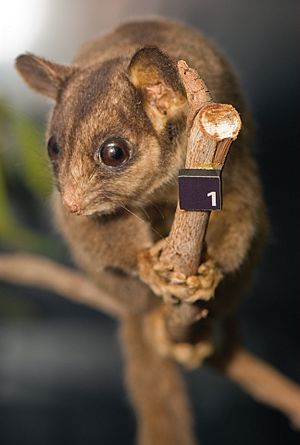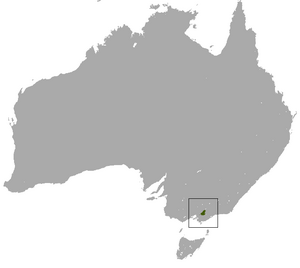Leadbeater's possum facts for kids
Quick facts for kids Leadbeater's possum |
|
|---|---|
 |
|
| Taxidermy specimen | |
| Conservation status | |
| Scientific classification | |
| Kingdom: | |
| Class: | |
| Infraclass: | |
| Order: | |
| Family: | |
| Genus: |
Gymnobelideus
|
| Binomial name | |
| Gymnobelideus leadbeateri |
|
 |
|
The Leadbeater's possum (Gymnobelideus leadbeateri) is an endangered species of Australian possum. It was once thought to be extinct. Today, it lives only in small areas of old and mixed-age mountain ash forests. These special forests are found in the central highlands of Victoria, Australia, north-east of Melbourne.
Sadly, about half of this possum's home was burned in the huge Black Saturday bushfire in 2009. Large parts of the forest near Marysville, Narbethong, and Healesville were destroyed. These possums need food all year round. They also need trees with natural holes where they can hide during the day. This means they can only live in wet sclerophyll forests that have a mix of old and new trees, plus a thick layer of Acacia plants.
This possum is the only species in the Gymnobelideus group. It was named after John Leadbeater, who was a taxidermist at the Museum of Victoria. Because it's the only mammal found only in Victoria, the state made the Leadbeater's possum its animal faunal emblem in 1968.
Contents
History of the Leadbeater's Possum
Europeans first found the Leadbeater's possum in 1867. Only five possums were seen, with the last one found in 1909. People believed the species was extinct. This was because its home near the Bass River in south-west Gippsland was cleared for farms in the early 1900s.
But then, in 1961, a group of these possums was discovered near Marysville. This was in the Upper Yarra Valley. More searches found other groups in the highlands of Victoria. However, the type of forest is very important for them. It cannot be too old or too young.
The possum's survival is thought to be linked to the terrible Black Friday fires in 1939. These fires burned across Victoria. They created a lot of new plant growth in the forest, which gave the possums more food. The fires also left many large, dead trees. These trees provided shelter and nesting spots. The Leadbeater's possum population grew to about 7,500 in the early 1980s.
After the 2009 fires, it's believed there are now only about 1,000 possums left. Many old trees have decayed, and there isn't much new growth. Before Europeans arrived, possums could simply move to new areas that had recently burned. But now, with so much land cleared, they have nowhere else to go. If about 1,000 possums can survive for another 150 years, natural tree hollows will start to form. These hollows will be in the trees that grew after the 1939 fires and survived the 2009 fires. This should help possum numbers grow again.
Leadbeater's Possum Habits and Lifestyle
Leadbeater's possums are rarely seen. They are nocturnal, meaning they sleep during the day and come out at night. They are small, about 33 cm (13 in) long. They weigh about 120-130 grams, which is about the same as a small apple. They move very quickly. These possums live at the top of some of the tallest forests in the world.
The possum has thick, soft fur. Its fur can be grey to brown, with a black stripe along its back. The fur on its chest and stomach is pale grey. One of the main things that makes this possum special is its club-shaped tail.
Family Groups and Social Life
Leadbeater's possums live in small family groups. A group can have up to 12 possums. Usually, it's a breeding pair, their children, and sometimes one or two extra males. They all sleep together in a nest. This nest is made from shredded bark inside a tree hollow. These nests can be anywhere from 6 m (20 ft) to 30 m (98 ft) above the ground.
Each family group has a territory of up to 20,000 square meters. They will defend this area from other possums. The oldest female in the group is usually the most aggressive. She will attack outsiders. She also chases her own daughters out of her territory when they become adults, usually around 14 months old. In the wild, a female possum lives for about 27 months on average. But in zoos, they can live as long as 10 years.
Leadbeater's possums do not survive well by themselves. Young males leave their parents around 15 months of age. They might join another group, or live together in large male groups. These male groups look for females to start new families.
Feeding Habits
At sunset, Leadbeater's possums leave their nests. They go out to find food in the tree tops. They often take huge leaps from tree to tree. They are omnivorous, meaning they eat both plants and animals. They eat different tree saps, lerps, and arthropods. They find these under the loose bark of eucalyptus trees. Their diet includes spiders, crickets, and beetles. They get their energy from the tree sap and their proteins from the arthropods.
Reproduction and Life Cycle
Leadbeater's possums give birth at the start of winter (May and June) or in late spring (October and November). They usually have one or two babies. The babies stay in their mother's pouch for 80 or 90 days. After they leave the pouch, they stay in the nest for another three weeks. Young Leadbeater's possums are often hunted and eaten by owls.
Status and Conservation Efforts
The Leadbeater's possum is an endangered species. This is because they live in a very small area. They also need a specific mix of forest trees to survive. Logging, which is cutting down trees for wood, continues to be a big danger to the possum. For example, in 1993, five hectares of protected possum habitat near Powelltown were logged by mistake.
Author Peter Preuss noted that the number of possums dropped in 1997. Their habitat, which is limited to a 50-square-kilometre area, was still threatened by logging. He said that a new breeding program was needed to help them.
Dr. David Lindenmeyer, from the Australian National University, has explained that the need for nest boxes shows a problem. He said that logging was removing too many older trees. These old trees have hollows that species like the Leadbeater's possum need for homes. Studies have shown that logging in the forest between the Yarra Valley National Park and Mount Bullfight Conservation Reserve in February 2006 led to the deaths of most possums in that area. Adult possums like to stay in their own territory and do not want to move. Many more possums were killed in early 2007. This happened when VicForests cleared large firebreaks through possum habitat after the Christmas fires. Firebreaks and cleared land stop the possums from being able to travel and breed with other nearby groups.
Much of the possum's known habitat was destroyed in the bushfires of February 2009. This means the species' future is now very uncertain. The areas where Leadbeater's possums were known to live exactly matched the areas burned in the fires.
The last Leadbeater's possum living in a zoo died at Healesville Sanctuary Victoria in May 2006. There are now no Leadbeater's possums in captivity anywhere in the world. This means there is no breeding program to help this animal survive. A group called Friends of Leadbeater's Possum has formed. They are working to protect the possum and to get the government to protect its home.
Images for kids
See also
 In Spanish: Falangero de Leadbeater para niños
In Spanish: Falangero de Leadbeater para niños




